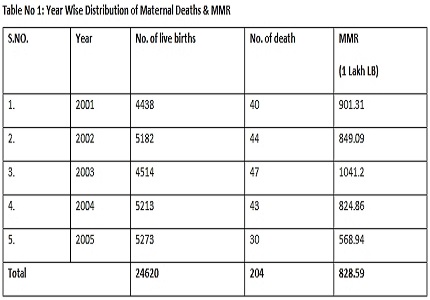To study maternal mortality and complications leading to maternal death in the tertiary care centre
Abstract
Objective: To study maternal mortality and complications leading to maternal death in the tertiary care centre over the five years of period.
Method: A retrospective and prospective study of all maternal deaths from January 2001 to December 2005 was carried out.
Results: There were total 204 maternal deaths out of 24,620 live births giving a maternal mortality rate (MMR) of 828.59 per 100,000 live births. Unbooked cases accounted for 74% of maternal deaths. The majority of deaths occurred in 25-29 years age group and 71% were multigravida. Out of 204 maternal deaths 72.06% deaths were due to direct causes. Hemorrhage was the commonest cause of death (36%) followed by toxaemia of pregnancy (19%) and sepsis accounted for 135 of deaths.
Conclusion: Hemorrhage, toxaemia of pregnancy and sepsis were found to be direct major cause of death. Anaemia and other indirect causes like jaundice, malaria, heart disease were other indirect causes of deaths.
Downloads
References
2. Bhat PN, Navaneetham K, Rajan SI. Maternal mortality in India: estimates from a regression model. Stud Fam Plann. 1995 Jul-Aug;26(4):217-32.
3. Bhat PN. Maternal mortality in India: an update. Stud Fam Plann. 2002 Sep;33(3):227-36. [PubMed]
4. Registrar General of India. maternal mortality in India 1997-2003. Trends, causes and risk factors. Report 2006, Registrar General India: New Delhi, p. 1-29. [PubMed]
5. Singh P, Pandey A, Aggarwal A. House to house survey vs. snowballing survey technique for capturing maternal deaths in India: A pilot study in search of cost effective method. Indian J med Res 125[2007] 60. [PubMed]
6. ACOG Committee Opinion. American College of Obstetrician and Gynecologist. ACOG Committee Opinion. Number 283, May 2003. New U.S. Food and Drug Administration labeling on Cytotec (misoprostol) use and pregnancy. Obstet Gynecol. 2003 May;101(5 Pt 1):1049-50.
7. Puri A, Yadav I, Jain N. Maternal mortality in an urban Tertiary care hospital of north India. J Obstet Gynaecol India. 2011;61:280–5. [PubMed]
8. Jain M, Maharahaje S. Maternal mortality: A retrospective analysis of ten years in a tertiary hospital.Indian J Prev Soc Med. 2003;34:103–11.
9. Jadhav AJ, Rote PG. Maternal mortality–changing trends. J Obstet Gynaecol India. 2007;57:398–400.
10. Pal A, Ray P, Hazra S, Mondal TK. Review of changing trends in maternal mortality in a rural medical college in west Bengal. J Obstet Gynecol India. 2005;55:521–4.
11. Onakewhor JU, Gharoro EP. Changing trends in maternal mortality in a developing country. Niger J Clin Pract. 2008 Jun;11(2):111-20. [PubMed]
12. Shah RJ, Ali I, Banday A, Fazili A, Khan I. Analysis of maternal mortality in a small teaching hospital attached to tertiary care hospital. Indian J Community Med. 2008;33:260–2. [PubMed]
13. Murthy BK, Murthy MB, Prabhu PM. Maternal Mortality in a Tertiary Care Hospital: A 10-year Review. Int J Prev Med. 2013 Jan;4(1):105-9. [PubMed]
14. van den Broek N. Anaemia and micronutrient deficiencies. Br Med Bull. 2003;67:149-60.



 OAI - Open Archives Initiative
OAI - Open Archives Initiative


